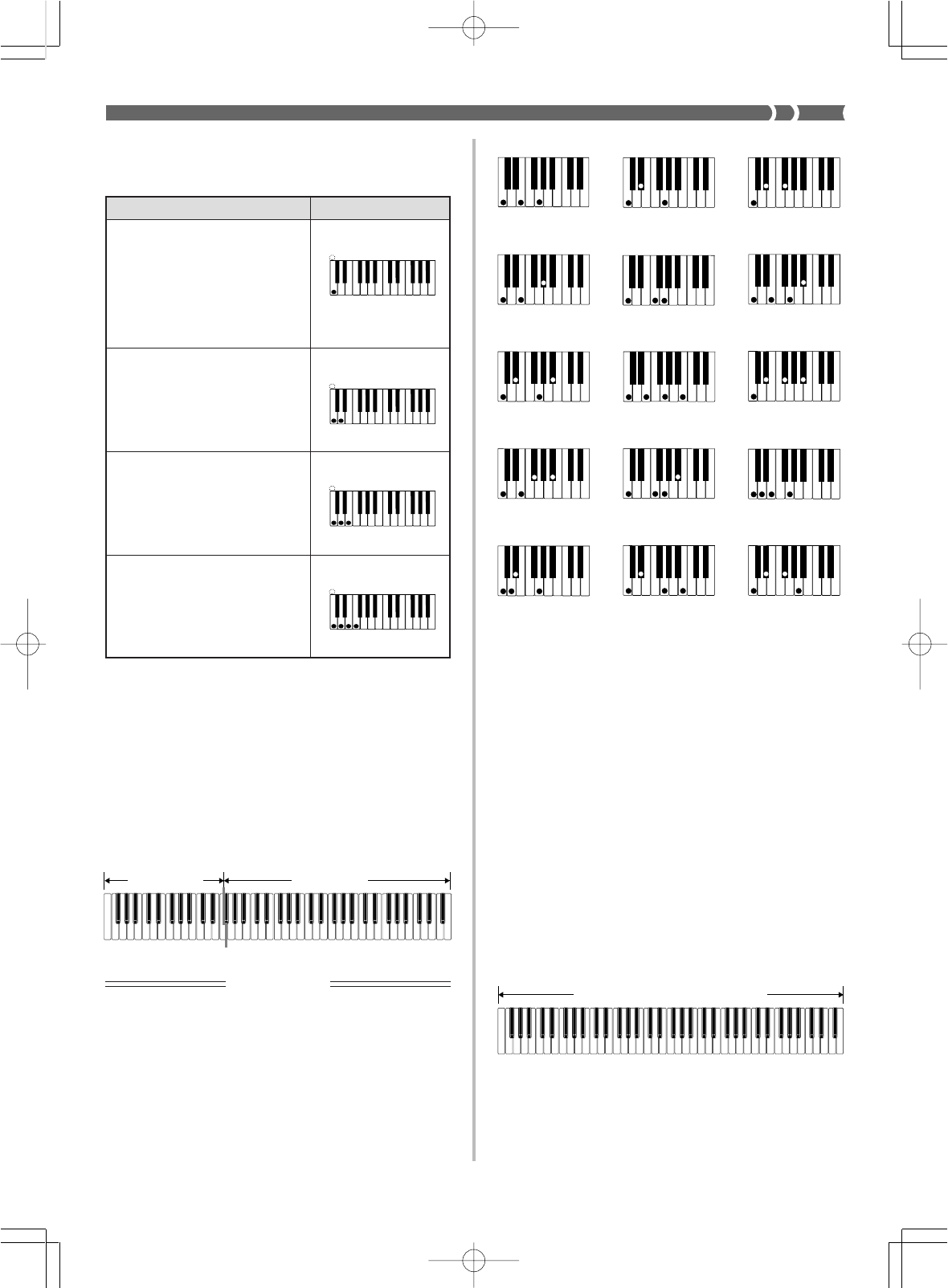
E-23
733A-E-025A
Chord Types
CASIO CHORD accompaniment lets you play four types of chords
with minimal fingering.
❚
NOTE
❚
It makes no difference whether you press black or white keys to the right
of a major chord key when playing minor and seventh chords.
■
FINGERED
FINGERED provides you with a total of 15 different chord types. The
following describes the FINGERED “Accompaniment keyboard” and
“Melody keyboard”, and tells you how to play a C-root chord using
FINGERED.
FINGERED Accompaniment Keyboard and Melody Key-
board
Major chords
Major chord names are marked above
the keys of the accompaniment key-
board. Note that the chord produced
when you press an accompaniment
keyboard does not change octave, re-
gardless of which key you use to play
it.
Minor chords (m)
To play a minor chord, keep the ma-
jor chord key depressed and press any
other accompaniment keyboard key
located to the right of the major chord
key.
Seventh chords (7)
To play a seventh chord, keep the
major chord key depressed and press
any other two accompaniment key-
board keys located to the right of the
major chord key.
Minor seventh chords (m7)
To play a minor seventh chord, keep
the major chord key depressed and
press any other three accompaniment
keyboard keys located to the right of
the major chord key.
ExampleChord Types
C Major (C)
C seventh (C7)
C minor (Cm)
C minor seventh (Cm7)
IMPORTANT!
The accompaniment keyboard can be used for playing chords only. No
sound will be produced if you try playing single melody notes on the ac-
companiment keyboard.
Melody keyboard
Accompaniment
keyboard
See the “Fingered Chord Chart” on page A-6 for details on playing
chords with other roots.
*1: Inverted fingerings cannot be used. The lowest note is the root.
*2: The same chord can be played without pressing the 5th G.
❚
NOTES
❚
• Except for the chords specified in note
*1
above, inverted fingerings (i.e.
playing E-G-C or G-C-E instead of C-E-G) will produce the same chords
as the standard fingering.
• Except for the exception specified in note
*2
above, all of the keys that
make up a chord must be pressed. Failure to press even a single key
will not play the desired FINGERED chord.
■
FULL RANGE CHORD
This accompaniment method makes it possible to play a total of 38
chord variations: the 15 available with FINGERED plus 23 addition-
al variations. The keyboard interprets any input of three or more keys
that matches a FULL RANGE CHORD pattern to be a chord. Any
multi-key input that is not a FULL RANGE CHORD pattern is inter-
preted as melody play. Because of this, there is no need for a separate
accompaniment keyboard, and the entire keyboard from end-to-end
can be used for both melody and chords.
FULL RANGE CHORD Accompaniment Keyboard and
Melody Keyboard
C7
*2
Cm7
*2
C Cm Cdim
Caug
*1
Csus4
Cmaj7
*2
Cm7
-5
C7
-5 *1
C7sus4 Cadd9
*2
Cmadd9
*2
CmM7
*2
Cdim7
*1
Accompaniment keyboard/Melody keyboard
C
C
DE FF
#
E
#
G
A
AB
B
C
C
DE F
E
#
C
C
DE FF
#
E
#
G
A
AB
B
C
C
DE F
E
#
C
C
DE FF
#
E
#
G
A
AB
B
C
C
DE F
E
#
C
C
DE FF
#
E
#
G
A
AB
B
C
C
DE F
E
#
WK-1800/1600(E)-21~27 03.7.31, 5:20 PMPage 23 Adobe PageMaker 6.5J/PPC


















